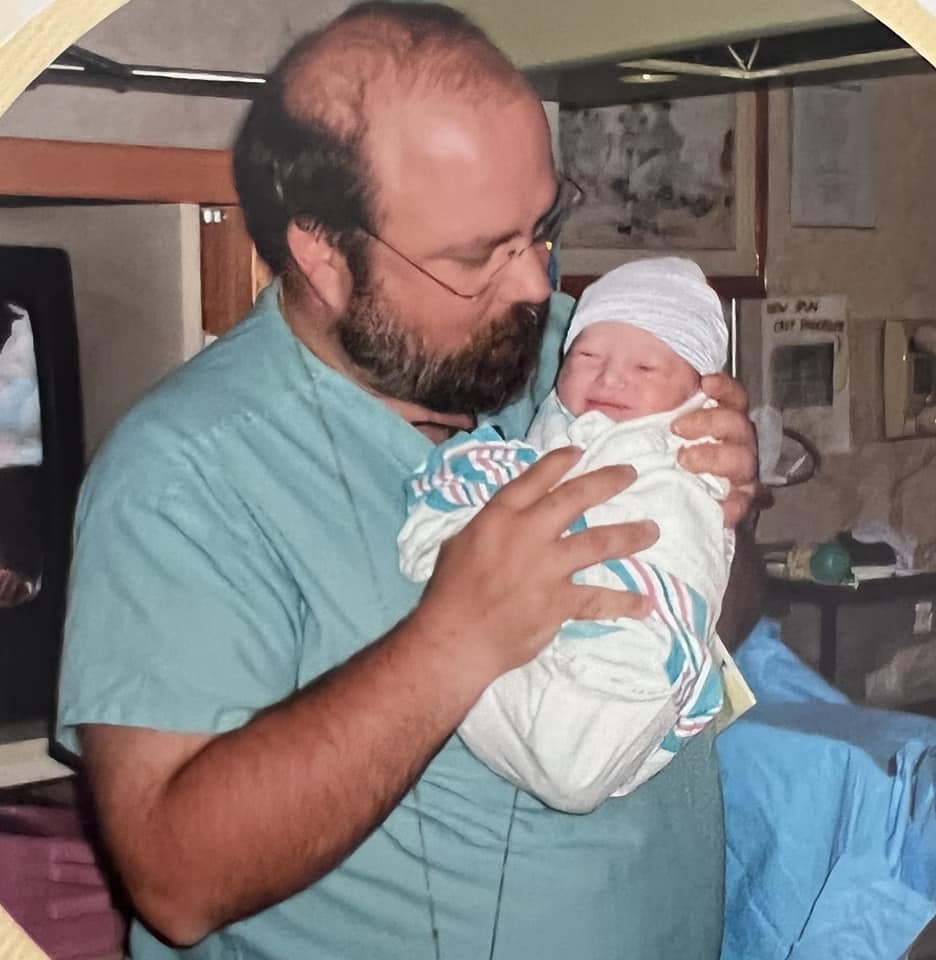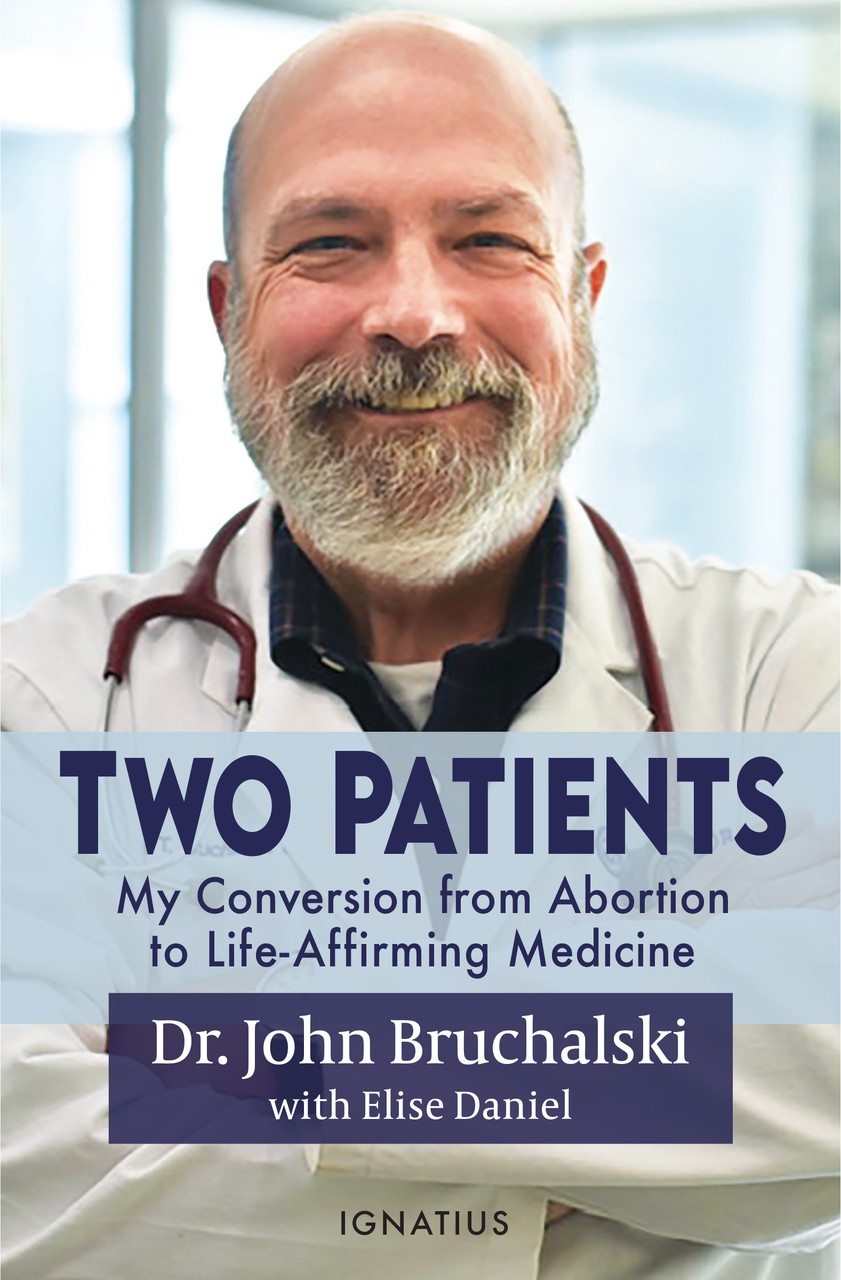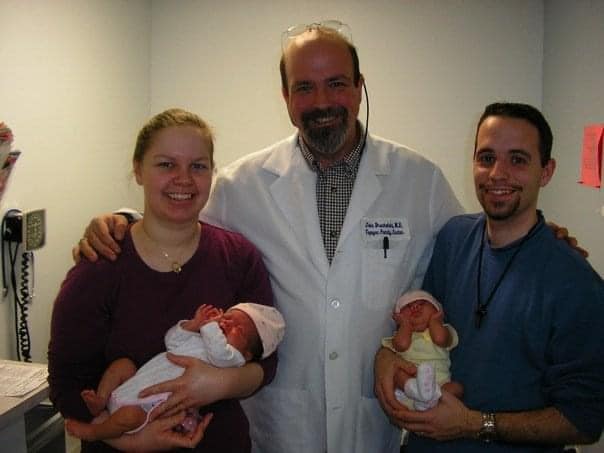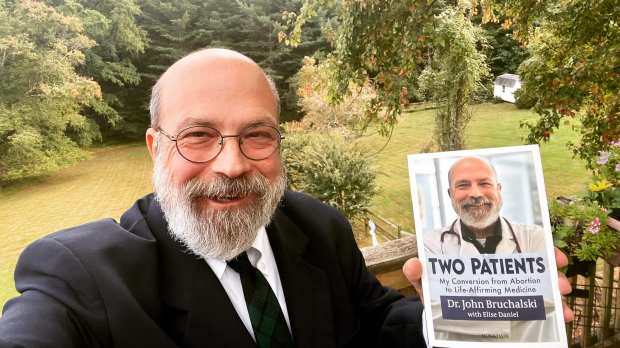John Bruchalski is a 62-year old-husband, father, and OB/GYN physician. In October 2022, Ignatius Press published his memoir, which chronicles what Bruchalski calls his “graced path to conversion.” The book is titled Two Patients: My Conversion from Abortion to Life-Affirming Medicine.
Bruchalski grew up in a northern New Jersey Polish family, the oldest of three boys. Described as “faithful and fun,” his mom was a prayerful stay-at-home mom and his dad was Latin and religion teacher at a Salesian Prep school.
“Being altar boys, playing baseball, Polish family kielbasa-Iron-Butchers, and fishing with mom and family were staples growing up,” says Bruchalski.
His father routinely took students to the March for Life.
“I clearly remember, as I was practicing foul shots in my driveway one cold January morning in 1973, my father identifying the day as ‘Black Monday,’ when we, as a nation, legalized the killing in the womb of mothers’ unborn children,” Bruchalski. “Little did I know, with my knack for the sciences and with mentors who encouraged me to look at medicine as a profession, that I would one day tell my parents I was performing abortions.”
Through his parents’ prayers and God’s mercy and grace, Bruchalski says the hardness of his heart was eventually repaired. Aleteia spoke with him about how he went from performing abortions to launching a pro-life women’s health center and writing his new memoir.

Aleteia: What led you to think that abotion was a good medical solution for women?
There were really three intertwined reasons why I adopted the mindset that abortion was good medicine for women. It began with my education and my peers growing up in the late 1970s and continued through my medical training and up to half of my residency to the winter of 1989.
I grew up during the so-called “sexual revolution.” In my formative years outside the home, both male and female friends were speaking openly about their sexual freedom, the freedom from parents and traditions, and the liberation from “myths” they had been brought up to believe as gospel. So, my friends were the “living books” I read, studied and listened to during those early years of my life. If these were the values of my peers, if this liberation was so important to happiness, as a doctor I should provide such medical services to women.
My faith journey outside of my family and parish in the 1970s and 1980s was filled with what were, at the time, several pillars of the new formation of our Catholic faith. My conscience, I began to believe, was my supreme guide and the Church could not force me to change my mind. My Church was just one of many paths to God. The saints were the folks of everyday, struggling to deal with the impossible and insurmountable structures and situations that engaged our hearts. We focused on the social principles of the Bible rather than those myths of saints and miracles. As a generation, we were diluted of the mercy of the truth and tradition of the Catholic Church.
My journey into studying the scientific taught me that what my faith taught me was backward, dangerous and a curse on women and science and medicine. Abortion, contraception, making embryos, sterilization and morning-after pills were all essential reproductive health that “people” have a right to for their own health and happiness. Everything outside this “evidence based approach” was heresy.
What changed?
The change came for me in early 1989. I was an OB/GYN resident living in the status quo, practicing so-called “good medicine.” Cognitive dissidence was building up inside me. At night I was visiting a pregnancy resource center, getting to see the faith of an evangelical community work to rescue women from abortion. During the day I was performing atrocities as an honorable and caring OB/GYN. Medical data in our journals were clearly indicating the dangerous side effects of abortion and its association with mental illness, preterm birth, and breast cancer. But with each abortion I performed my heart grew harder and harder, less and less, darker and darker.
Then an honest Catholic NICU doctor, Dr. Debbie Plumb, challenged me to stop treating her patients, these babies, as tumors to be cut out and discarded. Over coffee, soon after, she also challenged me to go and visit Medjugorje. My mother, it seemed coincidently at the time, asked me to accompany her there for winter break. There in Yugoslavia, in prayer, the scales fell away from my eyes. I became a redeemed sinner and I was touched in the sacred font of Divine Mercy through the assistance of His Blessed Mother.

What is the significance of the title of your new book, ‘Two Patients,’ and how does it impact your work?
Once His love and truth and mercy convince you how deeply you are “beloved,” you understand how undeserving you are of all of His gifts, and you are so grateful.
I came back from Medjugorje understanding that I could never ever go back to the medicine I was practicing. Our Mother instructed me to be the best doctor I could be, to see the poor daily and to follow the teachings of her Son’s Church.
By 1994 I had founded Tepeyac OB/GYN. My heart was exploding in fire to share what merciful, life-affirming medicine could be with other practitioners and with patients. Hope in God’s mercy is the grace of faith, which is love in action. Two Patients is the way of medicine when you desire with your whole being to integrate the best of modern medicine with the healing presence of Jesus Christ.
What makes the Tepayac center, which you founded, unique?
There are two unique aspects of Tepeyac OB/GYN (founded as Tepeyac Family Center) and Divine Mercy Care, which is the non-profit organization I founded to support the work of Tepeyac.
First, our Foundation of care is one of almsgiving. Medicine is an act of mercy. It is about seeing Christ in the eyes of the least — the sick, the vexed, the underserved and poor. Medicine is about relationships, not only doctor and patient, allowing the community you serve to participate by sacrificially providing alms to take care of its own. We are not for profit. We believe begging is becoming, as the history of Christianity has shown for millennia. Each year since our start in 1994, 30-40% percent of our practice has been underserved patients and all that entails. Our model allows us to provide comfort and care when the reductionist biomedical model fails.
Second, our essence is “comprehensive, collaborative, restorative, integrated women’s health.” Rather than seeing fertility as something to be controlled and shut off and polluted with class one carcinogens, fertility awareness is utilized fully. Rather than considering unborn children as sexually transmitted diseases, the unborn child is our second patient. Rather than treating embryos as property to be used, children and progeny are to be unconditionally loved and nurtured. Rather than seeing the underserved as someone else’s problem to be fixed and a waste of precious time, we do what we can to accompany our patients. Rather than pitting mom against her child in elective abortion, we collaborate with regional pregnancy centers. Without judgment, we tell the truth. Rather than seeing a sick unborn child in the womb as a sump for pain and needless suffering and ending the life of the person/child with that illness, we offer perinatal hospice.
Post-Roe, what should the pro-life movement be focused on?
The meaning of words and the science of logic are now “transhuman.” What I mean by that is we are transcending human limits in nihilistic ways without a guiding star outside of us and our thought. It is so dangerous.
As I learned in my past, mercy without the foundations of science, logic, and Abba — that is the unity of faith and reason — we are lost. It is the breaking of that unity that led to the sterilizing tables in the 1930s, the gas chambers in the 1940s, and now to the abortion mills and chemical abortions of today.
In a post-Roe world, we must continue the political and the advocacy and the scientific inquiry. We must grow the model we have created at Tepeyac — to serve human flourishing, collaborate with fertility, and not treat our children as sexually transmitted diseases to be altered or eliminated. Finally, we must continue to change hearts. As I experienced medicine in general, the primary way going forward in my field of OB/GYN is to fight the present culture of lies by living intentionally and living in the enlightenment of truth instead of merely talking about it. We must be witnesses. Through God’s grace, and in sacrificial relationship with others, we can provide a light in the darkness and show that the way of medicine going forward must be toward care, healing and and wholeness.

Dr. Bruchalski’s memoir Two Patients: My Conversion from Abortion to Life-Affirming Medicine is published by Ignatius Press.

